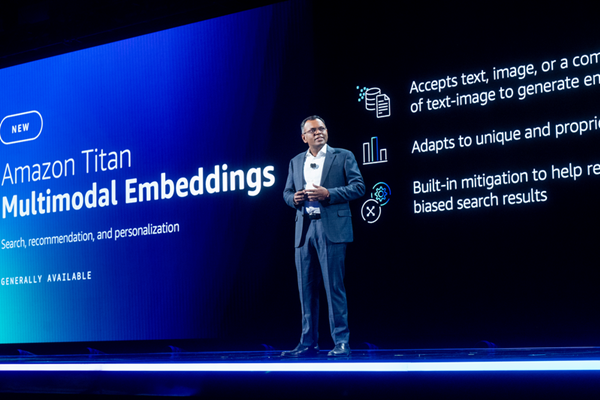AWS Augments Amazon Bedrock With New Features, Titan Models, Agents
 Amazon Web Services (AWS) unveiled several features to its generative AI app-building platform Amazon Bedrock, including new large language models (LLMs) and other foundation models (FMs), during its annual re:Invent conference. The releases aim to simplify access to third-party models like Anthropic’s Claude 2.1, widen the portfolio of Amazon’s Titan models to include new variants and an image generator, and give developers more tools to evaluate, customize, and govern generative AI systems for enterprise use cases like creating agents.
Amazon Web Services (AWS) unveiled several features to its generative AI app-building platform Amazon Bedrock, including new large language models (LLMs) and other foundation models (FMs), during its annual re:Invent conference. The releases aim to simplify access to third-party models like Anthropic’s Claude 2.1, widen the portfolio of Amazon’s Titan models to include new variants and an image generator, and give developers more tools to evaluate, customize, and govern generative AI systems for enterprise use cases like creating agents.
Amazon Bedrock Boom
AWS Vice President of Data and AI Dr. Swami Sivasubramanian unveiled the new Amazon Bedrock capabilities, showcasing how they allow quicker experimentation across models and safer deployment into production environments. The platform now hosts newly-added models, including Meta’s 70 billion-parameter Llama 2, AI21 Labs’ Claude 2.1, and Amazon’s own Titan with multimodal embeddings model for processing combined text and images. He described how an open catalog approach lets organizations select ideal models for their needs as this technology rapidly evolves. Developers can also fine-tune certain models on proprietary data to tailor performance. Sivasubramanian maintained Amazon Bedrock’s open architecture, supporting varied models and its security controls, which give AWS advantages. AWS hopes embedding Amazon Bedrock’s inferencing abilities natively into services like contact center Amazon Connect will ease adoption.
“Generative AI is poised to be the most transformational technology of our time, and we are inspired by how customers are applying it to new opportunities and tackling business challenges,” Sivasubramanian said. “As customers incorporate generative AI into their businesses, they turn to Amazon Bedrock for its choice of leading models, customization features, agent capabilities, and enterprise-grade security and privacy in a fully managed experience. With even more tools at their fingertips, customers are using Amazon Bedrock to leverage the full potential of generative AI to reimagine user experiences, reinvent their businesses, and accelerate their generative AI journeys.”
A notable addition to Amazon Bedrock is the general availability of agents, a kind of generative AI program automating multi-step tasks. The agents offer help in several roles, particularly cross-system coordination which is normally a manual task. The upgraded agents also provide developers with more transparency behind their reasoning process. Developers can see the chain of thought (CoT) detailing how the agent tackled each sub-task and the reasoning steps provide troubleshooting suggestions to refine prompts for desired behaviors. Developers can now edit Agents’ auto-generated prompts guiding the model’s inferences to further tune performance. Pre- and post-processing templates alongside orchestration flows permit customizations.
Amazon Bedrock has also added new features for enforcing responsible AI practices, like pipelines to benchmark models on custom metrics and content filtering to block toxic outputs. There are also new guardrails that let developers configuring filters based on categories like hate speech and violence thresholds to ensure appropriate responses. Admins will soon be able to redact personally identifiable info as well. Additionally, Knowledge Bases connects Bedrock’s models with internal data sources to make responses more contextual via an AI technique called retrieve and augment.
Follow @voicebotai Follow @erichschwartz
Amazon Counters OpenAI’s GPT Builder With AWS Bedrock Generative AI App Creator PartyRock








